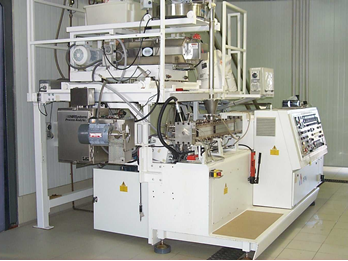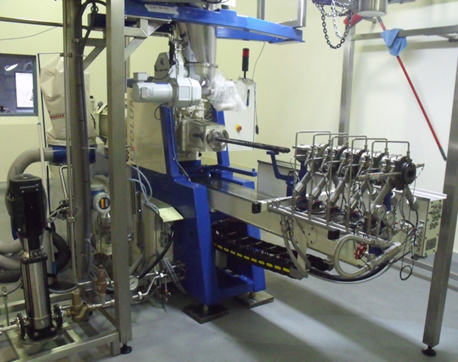CSIRO Extrusion History
The following information is based on an Extrusion Community of Practice session presented by Jay Sellahewa – Adjunct Fellow at UNSW Sydney – on May 30th 2024.

1993 – APV baker MPF 40 (North Ryde, NSW)

2012 – Clextral Evolum 32 (Werribee, VIC)
History of CSIRO’s Smart Extrusion Program
The foundations of CSIRO’s Smart Extrusion Program trace back over 30 years, when a decision was made in 1992 to develop capability in extrusion technology at CSIRO to address the demand from industry for innovation in food extrusion technology and pilot-scale processing. The vision was to develop a centre of excellence in extrusion technology with critical infrastructure, support services and other resources to enable the development of new knowledge and the transfer of this knowledge to industry.
From the outset, there were close interactions with industry and the CSIRO facilities were made available for industry use. The centre was located at CSIRO’s Food Science and Technology Division in North Ryde and one of the features of this centre was close collaboration with other disciplines within CSIRO as well as with local and overseas universities to establish multidisciplinary teams. This resulted in the development of new knowledge, enabling the development of innovative products.
A pilot-scale twin-screw extruder and other infrastructure was installed in North Ryde in 1993 and following a successful operation, the facilities in North Ryde were closed in 2009. However, CSIRO’s extrusion capability shifted to Werribee and an up to date, new extrusion facility was opened in CSIRO’s Food Innovation Centre in Werribee in 2012, where CSIRO continues to provide a service to the food and feed industry through R&D and training.
Key Milestones
- Early Development (1991–1996)
The team built infrastructure, recruited staff, and began working with industry. Despite limited resources, CSIRO hosted four successful international extrusion symposia and delivered fee-for-service projects to meet immediate industry needs. - Golden Era (1997–2003)
With growing credibility and infrastructure in place, the team secured substantial commercial and government funding. Research focused on understanding the interactions between raw materials, process conditions, and product quality—core principles of process and systems engineering. - Pioneering Research Areas
- Process monitoring and control (including acoustic and NIR sensors)
- High moisture extrusion for meat analogues (long before it became a trend)
- Online product quality measurement
- Use of extruders as chemical reactors for food functionality
- Residence time distribution and die design
- Process Systems Engineering in Food
CSIRO integrated systems engineering principles, collaborating with control engineers at the University of Newcastle and Sydney University to apply model-based control systems to extrusion. This enabled more efficient processes and laid the groundwork for today’s digital twins and intelligent extrusion tools.
Smart Extrusion Symposia
CSIRO’s Smart Extrusion Program also played a key role in knowledge exchange and community building through its Smart Extrusion Symposia.
- Four successful Symposia events were organised between 1997 and 2003, showcasing cutting-edge research and industry insights
- Featured speakers from local and international research institutions, food companies, and equipment suppliers
- Offered an excellent platform for networking, knowledge sharing, and forming collaborations
- One symposium held in Bangkok, Thailand, expanding outreach into the Asia-Pacific region
- Another was linked to an extrusion course co-organised with the American Association of Cereal Chemists International (AACCI), merging training with technical presentations
Research Projects During This Time
- Mathematical Modelling of Extrusion
- Mechanistic modelling of heat, mass, and momentum transfer
- Predicted temperature, pressure, SME, RTD, and barrel fill
- Development of a graphical user interface for model visualisation
- Data Analytics & Statistical Process Control
- Analysed raw material and processing impacts on product quality
- Studied sampling variability and measurement accuracy
- Smart Process Monitoring & Control
- Investigated process dynamics
- Applied model predictive control to manage moisture and density
- Residence Time Distribution (RTD) Studies
- Developed simple RTD method using NaCl tracers
- Assessed impact of screw speed, feed rate, and configuration
- Product Characterisation & Quality Benchmarking
- Developed a methods manual
- Measured glass transition temperatures (DSC)
- Image Analysis of Extruded Products
- Quantified bubble size and wall thickness
- Linked structure to texture in expanded snacks
- Acoustic Quality Assessment
- Used sound emissions to predict product bulk density and degree of cook
- Validated under commercial conditions
- Near Infrared Spectroscopy (NIRS)
- Correlated NIR spectra with 14 sensory and instrumental attributes
- Demonstrated NIRS as a molecular fingerprinting tool
- Soft Sensors for Quality Prediction
- Predicted moisture content and bulk density using process data
- Extruder as a Reactive System
- Investigated starch gelatinisation, flavour formation, sugar modification
- Explored enzyme inactivation kinetics
- High Moisture Extrusion
- Developed textured meat and plant-based protein products
- Extruder Scale-Up Studies
- Evaluated process consistency across extruder types and sizes
- Die Design
- Developed a semi-empirical model to guide die geometry design
- Sensory Analysis
- Characterised how operating conditions affect product sensory profiles
- Microbial Inactivation
- Conducted challenge tests with Bacillus cereus spores
- Studied effects of shear, temperature, moisture, and screw speed
Legacy and Reflections
- The Smart Extrusion Program built critical national infrastructure and capability for extrusion research and innovation
- The program produced many internal reports, 12 conference papers, 4 journal papers, 3 book chapters, 5 Postgraduate theses
- The work laid a foundation for modern developments in food material science, predictive modelling, and advanced control systems
- Importantly, the program championed a collaborative model involving academia, industry, and multidisciplinary CSIRO teams
Looking Forward: Future Research Opportunities
Building on past success, future research areas aim to tackle new technical and societal challenges through advanced processing, sustainability, nutrition, and digitalisation:
Product & Process Understanding
- Exploring process–product interactions to enhance control and predictability
- Investigating structure–function relationships in extruded foods
- Designing healthier products with reduced fat, salt, and sugar while preserving taste and texture (e.g., using food material science to reduce glycaemic index)
New & Sustainable Ingredients
- Incorporating novel raw materials, including ancient grains (e.g. amaranth), legumes and pulses, and sorghum
- Adding value to low-value ingredients, by-products, and food waste streams
- Using extrusion to encapsulate bioactives and protect functional ingredients
High Moisture & Co-Extrusion Technologies
- Advancing high moisture extrusion for premium plant-based meat analogues
- Enhancing use of low-quality meat through structural transformation
- Exploring novel applications of co-extrusion, with clean-label, additive-free formulations
Smart Processing & Digital Tools
- As sensors become cheaper and AI technologies more accessible, the time is right to revisit intelligent process control systems.
- Implementing on-line sensing and soft sensors and leveraging AI and Internet of Things (IoT) technologies is a pathway towards real-time process control. Real-time process control will be enabled through
- Mathematical modelling, predictive tools, Statistical process control
- High-speed computation
- Affordable, robust online sensors
- Improved process knowledge and software
- Viewing the extruder as a chemical and biochemical reactor to create new ingredients and functionalities
- Supporting semi-skilled operators with decision-support systems for consistent, efficient operation
